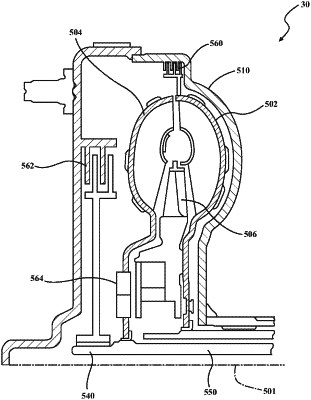| CPC F16H 45/02 (2013.01) [F16H 41/22 (2013.01); F16H 61/143 (2013.01); F16H 2041/246 (2013.01); F16H 2045/002 (2013.01); F16H 2045/0284 (2013.01)] | 3 Claims |

|
1. A system for bypassing a torque converter in a powertrain in a vehicle, comprising:
a torque generating device including an output shaft;
a transmission assembly including:
a transmission output shaft;
a torque converter, including
a rotatable outer housing configured to rotate about a rotating axis of the torque converter;
an impeller configured to rotate about the rotating axis;
a turbine configured to rotate about the rotating axis; and
a one-way clutch permitting torque transmission between the turbine and the transmission output shaft in one direction;
a torque converter bypass shaft disposed within the torque converter and configured to rotate about the rotating axis;
a disconnect clutch disposed within the torque converter and selectively coupling the torque converter with the torque generating device;
a torque converter clutch selectively coupling the torque converter bypass shaft with the torque generating device; and
a computerized transmission mode controller, operating programming to control the disconnect clutch and the torque converter clutch;
wherein engaging the disconnect clutch and disengaging the torque converter clutch enables the torque generating device to transmit torque to the transmission output shaft through the torque converter;
wherein engaging the torque converter clutch and disengaging the disconnect clutch enables the torque generating device to transmit torque to the transmission output shaft through the torque converter bypass shaft;
wherein the torque generating device is a motor-generator unit that utilizes electric energy to generate a motor-generator output torque and generates electrical energy from a torque transmitted to the output shaft of the motor-generator unit;
wherein the programming to control the disconnect clutch and the torque converter clutch includes:
when operation of the torque converter is desirable, engaging the disconnect clutch to cause an impeller of the torque converter to spin with the output shaft of the torque generating device and disengaging the torque converter clutch; and
when the operation of the torque converter is not desirable, disengaging the disconnect clutch to disconnect the impeller from the output shaft of the torque generating device and engaging the torque converter clutch; and
wherein operation of the torque converter is not desirable when the speed of the motor-generator, when acting as a motor, exceeds a maximum rotational speed limitation imposed by the torque converter.
|